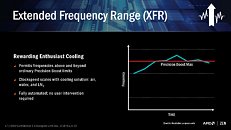Friday, February 10th 2017

AMD's "X" Nomenclature on Upcoming Ryzen Chips Related To XFR Feature
A Reddit user has used some good, old-fashioned thinking and inference (along with a good memory for details and investigative spirit) to try and shed some light on AMD's upcoming Ryzen chips - particularly, on the "X" part of their nomenclature.
As we've previously reported, upcoming AMD Ryzen chips will slot in two versions for each model: for example, there will be a R7 1700X, 8-core, 16-thread processor (with 95 W TDP), and expected to retail for $381.72, and a R7 1700 (sans "X"), also 8-core, 16-thread, with a rated TDP at 65 W, expected to retail at $316.59, almost $70 cheaper than the 1700X. Now, with AMD's promise of all Ryzen processors being multiplier unlocked (and thus user - or even through an automatic BIOS - overclockable), this would mean that acquiring the 1700X chip would somehow feel like bad business - after all, if the only difference between the two models were to be base and boost clocks (thus higher pricing and TDP), that would fall irrelevant to most power users, since the ability to overclock their Ryzen processors to those levels would be there anyway.Essentialy, AMD's "X" nomenclature regarding its upcoming Ryzen chips seems to denote the presence or absence of their touted XFR (eXtended Frequency Range) feature. This is part of AMD's SenseMI Technology suite, which aims to bring higher, intelligent performance to their Ryzen chips through the use of some particular technologies. XFR as it is, appears to be an added, automated overclocking capability to the chip, going further than the Precision Boost clocks would usually allow, supposedly scaling with the cooling performance of the end user's machine. This would fall in nicely with the rated TDP's of the non-X processors being rated at 65 W, with the X-branded, XFR-enabled processors featuring a higher theoretical TDP limit in-line with the capabilities of the XFR feature. As such, while it is true that an AMD Ryzen R7 1700 chip would also have base and boost clocks, much like their 1700X counterpart, the 1700's boost capabilities are designed for the chip not to surpass this 65 W hard limit. The 1700X, however, would be able to dynamically overclock according to the environment and cooling efficiency of the end user's rig, thus allowing it to, in some cases, hit a theoretical power consumption peak at the rated 95 W.
This theory (and AMD's strategy) would go some way to explain the high price difference between the 1700X and the 1700 R7 processors, which have a measly 100 MHz difference in their boost clocks favoring the 1700X (3.8 GHz vs 3.7 GHz on the 1700). After all, it still remains up in the air how good of an overclocker will AMD's ZEN architecture be, but a TDP difference of 30 W could go a long way overclocking-wise, especially when you consider AMD can apparently make these chips tick at 3.8 GHz with a measly 65 W TDP for an 8-core, 16-thread chip.
This strategy also makes sense in that power users who spend money on high-performance cooling solutions are probably more inclined to spend more on a CPU that promises (even if only theoretically) higher overclocking potential (we can expect these X chips to be cherry-picked samples with higher overclockability than other, non-X models). This also makes sense when one considers that the X versions of Ryzen chips are expected to ship with no cooling solution, whereas non-X models will ship with the company's "Wraith" cooling solution, more than enough for the non-power user who doesn't care about something like XFR. While it is a fact that most enthusiast users will simply buy the non-X chips and overclock them until the sky is no longer an achievement, it is also true that even some of us might feel more inclined towards simply "install and forget" high-performance, automatically-overclocked chips (also something the good Dr. Lisa Su mentioned during the "New Horizon" event, saying that XFR was "just for you enthusiast gamers").
Source:
Reddit user riuzaky2
As we've previously reported, upcoming AMD Ryzen chips will slot in two versions for each model: for example, there will be a R7 1700X, 8-core, 16-thread processor (with 95 W TDP), and expected to retail for $381.72, and a R7 1700 (sans "X"), also 8-core, 16-thread, with a rated TDP at 65 W, expected to retail at $316.59, almost $70 cheaper than the 1700X. Now, with AMD's promise of all Ryzen processors being multiplier unlocked (and thus user - or even through an automatic BIOS - overclockable), this would mean that acquiring the 1700X chip would somehow feel like bad business - after all, if the only difference between the two models were to be base and boost clocks (thus higher pricing and TDP), that would fall irrelevant to most power users, since the ability to overclock their Ryzen processors to those levels would be there anyway.Essentialy, AMD's "X" nomenclature regarding its upcoming Ryzen chips seems to denote the presence or absence of their touted XFR (eXtended Frequency Range) feature. This is part of AMD's SenseMI Technology suite, which aims to bring higher, intelligent performance to their Ryzen chips through the use of some particular technologies. XFR as it is, appears to be an added, automated overclocking capability to the chip, going further than the Precision Boost clocks would usually allow, supposedly scaling with the cooling performance of the end user's machine. This would fall in nicely with the rated TDP's of the non-X processors being rated at 65 W, with the X-branded, XFR-enabled processors featuring a higher theoretical TDP limit in-line with the capabilities of the XFR feature. As such, while it is true that an AMD Ryzen R7 1700 chip would also have base and boost clocks, much like their 1700X counterpart, the 1700's boost capabilities are designed for the chip not to surpass this 65 W hard limit. The 1700X, however, would be able to dynamically overclock according to the environment and cooling efficiency of the end user's rig, thus allowing it to, in some cases, hit a theoretical power consumption peak at the rated 95 W.
This theory (and AMD's strategy) would go some way to explain the high price difference between the 1700X and the 1700 R7 processors, which have a measly 100 MHz difference in their boost clocks favoring the 1700X (3.8 GHz vs 3.7 GHz on the 1700). After all, it still remains up in the air how good of an overclocker will AMD's ZEN architecture be, but a TDP difference of 30 W could go a long way overclocking-wise, especially when you consider AMD can apparently make these chips tick at 3.8 GHz with a measly 65 W TDP for an 8-core, 16-thread chip.
This strategy also makes sense in that power users who spend money on high-performance cooling solutions are probably more inclined to spend more on a CPU that promises (even if only theoretically) higher overclocking potential (we can expect these X chips to be cherry-picked samples with higher overclockability than other, non-X models). This also makes sense when one considers that the X versions of Ryzen chips are expected to ship with no cooling solution, whereas non-X models will ship with the company's "Wraith" cooling solution, more than enough for the non-power user who doesn't care about something like XFR. While it is a fact that most enthusiast users will simply buy the non-X chips and overclock them until the sky is no longer an achievement, it is also true that even some of us might feel more inclined towards simply "install and forget" high-performance, automatically-overclocked chips (also something the good Dr. Lisa Su mentioned during the "New Horizon" event, saying that XFR was "just for you enthusiast gamers").




71 Comments on AMD's "X" Nomenclature on Upcoming Ryzen Chips Related To XFR Feature
AMD must be very confident that these chips can hold ridiculously high clock speeds and have an accurate means for testing its upper limit.Pretty sure you'd have to disable XFR if you're going to overclock yourself. That said, all Ryzen chips have unlocked multipliers so you can overclock them all. If you do intend to overclock, it makes sense to go the X model because you can buy a beefier HSF without having one sitting around.
It'll be interesting to see if XFR does a better job at overclocking than people do. XD
ive used the last 3 gens of Amd gpus and the latest Polaris sets out what Will occour for me if the same tech is put into Cpus , and it is being.
my rx 480 controls clocks and power throughput so a max TDP is not exceeded ie the TDP now regulates what it is physically possible to put into power wise and hence get out performance wise............................................................many full stops end comment thats a fact.
i can bios flash a different bios , gain a higher tdp in firmware and then clock higher(not anymore mind because driver restrictions do not allow the dev bios to be used anymore) so i know this is how my present amd chip product is working and is controlled.
now apply that to Ryzen, possibly improved a bit and you get a scenario where the X versions will clock higher in loads and the none X parts hit a limit well within there specs.
this would very effectively control the value aspect of bothering with different Sku's, yes they all will oc but no every chip is certainly not equal.
A "could"would be appreciated.
However this story is based on currently announced, and weeks from launch CPUs that do not carry an IGP.
I prefer @theoneandonlymrk's take that XFR will be on all CPU's but the higher TDP will give the 'X' chips much greater headroom. Like if Nvidia allowed a higher power limit on it's GPU's, we might see higher clocks.
So since you are not clear. I don't think any of use understand WHY you want something that is already an option.